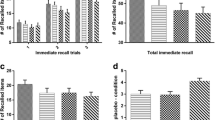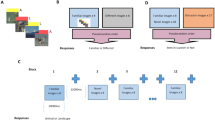Abstract
Free recall of words has been extensively used in psychopharmacology to assess the effects of CNS-active drugs on memory functions. However, there is a relative lack of information on the impact of word frequency on the subsequent recall of words following the administration of psychoactive drugs. The present double-blind, placebo-controlled, repeated-measures experiment used lorazepam and alcohol to test the effects of word frequency on immediate and delayed word recall in 24 healthy volunteers. One half of the words contained in the lists had a high frequency (HF) of occurrence and the remainder were of low frequency (LF). The results showed that LF words were more sensitive to memory impairment than HF words. However, the more accurate recall of HF words (with respect to LF words) was eliminated when a combination of lorazepam with alcohol was administered. These findings indicate that word frequency has a significant impact on memory and, as such, is a factor to be taken into account when using memory recall tasks to assess the effects of psychoactive drugs on memory.



Similar content being viewed by others
References
Aranko K, Seppala T, Pellinen J, Mattila MJ (1985) Interaction of diazepam or lorazepam with alcohol. Psychomotor effects and bioassayed serum levels after single and repeated doses. Eur J Clin Pharmacol 28:559–565
Baayen RH, Piepenbrock R, Van Rijn H (1993) The CELEX lexical database [CD-ROM]. Linguistic Data Consortium, University of Pennsylvania, Philadephia
Baddeley AD (1986) Working memory. Oxford University, Oxford
Baddeley AD, Hitch G (1974) Working memory. In: Bower GA (ed) Recent advances in learning and motivation, vol 8. Acadamic, New York, pp 47–90
Bareggi SR, Ferini-Strambi L, Pirola R, Smirne S (1998) Impairment of memory and plasma flunitrazepam levels. Psychopharmacology 140:157–163
Blin O, Simon N, Jouve E, HabibM, Gayraud D, Durand A, Bruguerolle B, Pisano P (2001) Pharmacokinetic and pharmacodynamic analysis of sedative and amnesic effects of lorazepam in healthy volunteers. Clin Neuropharmacol 24:71–81
Burns M, Moskowitz H (1980) Effects of diphenhydramine and alcohol on skills performance. Eur J Clin Pharmacol 17:259–266
Cohen J (1988) Statistical power analysis for the behavioral sciences, 2nd edn. Erlbaum, Hillsdale
Curran HV (1986) Tranquillising memories: a review of the effects of benzodiazepines on human memory. Biol Psychol 23:179–213
Curran HV (1991) Benzodiazepines, memory, and mood: a review. Psychopharmacology 105:1–8
DeLosh EL, McDaniel MA (1996) The role of order information in free recall: application to the word-frequency effect. J Exp Psychol [Learn Mem Cognit] 22:1136–1146
Dundee JW, George DA (1976) The amnesic action of diazepam, flunitrazepam and lorazepam in man. Acta Anaesthesiol Belg 27(Suppl):3–11
Ferrara SD, Giorgetti R, Zancaner S, Orlando R, Tagliabracci A, Cavarzeran F, Palatini P (1999) Effects of single dose of gamma-hydroxybutyric acid and lorazepam on psychomotor performance and subjective feelings in healthy volunteers. Eur J Clin Pharmacol 54:821–827
Ghoneim MM, Mewaldt SP (1990) Benzodiazepines and human memory: a review. Anesthesiology 72:926–938
Goodwin DW, Othmer E, Halikas JA, Freemon F (1970) Loss of short term memory as a predictor of the alcoholic “blackout”. Nature 227:201–202
Gorman AM (1961) Recognition memory for nouns as a function of abstractness and frequency. J Exp Psychol 61:23–29
Green JF, McElholm A, King DJ (1996) A comparison of the sedative and amnesic effects of chlorpromazine and lorazepam. Psychopharmacology 128:67–73
Gregg VH (1976) Word frequency, recognition, and recall. In: Brown J (ed) Recall and recognition. Wiley, London, pp 183–216
Gregg VH, Freedman CM, Smith DK (1989) Word frequency, articulatory suppression and memory span. Br J Psychol 80:363–374
Healey M, Pickens R, Meisch R, McKenna T (1983) Effects of clorazepate, diazepam, lorazepam, and placebo on human memory. J Clin Psychiatry 44:436–439
Hindmarch I, Subhan Z (1983) The effects of midazolam in conjunction with alcohol on sleep, psychomotor performance and car driving ability. Int J Clin Pharmacol Res 3:323–329
Hindmarch I, Haller J, Sherwood N, Kerr J (1991) Comparison of five anxiolytic benzodiazepines on measures of psychomotor performance and sleep. Neuropsychobiology 24:84–89
Hommer D, Weingartner H, Breier A (1993) Dissociation of benzodiazepine-induced amnesia from sedation by flumazenil pretreatment. Psychopharmacology 112:455–460
Hulme C, Roodenrys S, Schweickert R, Brown GD, Martin M, Stuart G (1997) Word-frequency effects on short-term memory tasks: evidence for a redintegration process in immediate serial recall. J Exp Psychol [Learn Mem Cognit] 23:1217–1232
Kerr J, Hindmarch I (1998) The effects of alcohol alone or in combination with other drugs on information processing, task performance and subjective response. Hum Psychopharmacol 13:1–9
Kucera H, Francis WN (1967) Computational analysis of present day American English. Brown University, Providence
MacLeod CM, Kampe KE (1996) Word frequency effects on recall, recognition, and word fragment completion tests. J Exp Psychol [Learn Mem Cognit] 22:132–142
Mandler G (1980) Recognizing: the judgment of previous occurrence. Psychol Rev 87:252–271
May RB, Tryk HE (1970) Word sequence, word frequency, and free recall. Can J Psychol 24:299–304
May RB, Cuddy LJ, Norton JM (1979) Temporal contrast and the word frequency effect. Can J Psychol 33:141–147
Micallef J, Soubrouillard C, Guet J, Le Guern ME, Alquier C, Bruguerolle B, Blin O (2001) A double blind parallel group placebo controlled comparison of sedative and amnesic effects of etiofoxine and lorazepam in healthy subjects. Fundam Clin Pharmacol 15:209–216
Minzer MZ (2003) Triazolam-induced amnesia and the word-frequency effect in recognition memory: support for a dual process account. J Mem Lang 48:596–602
O’Hanlon JF, Vermeeren A, Uiterwijk MM, Van Veggel LM, Swijgman HF (1995) Anxiolytics’ effects on the actual driving performance of patients and healthy volunteers in a standardized test. An integration of three studies. Neuropsychobiology 31:81–88
O’Neill WM, Hanks GW, Simpson P, Fallon MT, Jenkins E, Wesnes K (2000) The cognitive and psychomotor effects of morphine in healthy subjects: a randomized controlled trial of repeated (four) oral doses of dextropropoxyphene, morphine, lorazepam and placebo. Pain 85:209–215
Paivio A, Yuille JC, Madigan SA (1968) Concreteness, imagery and meaningfulness values for 925 nouns. J Exp Psychol 76(Suppl):1–25
Parkin C, Kerr JS, Hindmarch I (1997) The effects of practice on choice reaction time and critical flicker fusion threshold. Hum Psychopharmacol 12:65–70
Poirier M, Saint-Aubin J (1996) Immediate serial recall, word frequency, item identity and item position. Can J Exp Psychol 50:408–412
Polster MR (1993) Drug-induced amnesia: implications for cognitive neuropsychological investigations of memory. Psychol Bull 114:477–493
Ridout F, Shamsi Z, Meadows R, Johnson S, Hindmarch I (2003) A single-center, randomized, double-blind, placebo-controlled, crossover investigation of the effects of fexofenadine hydrochloride 180 mg alone and with alcohol, with hydroxyzine hydrochloride 50 mg as a positive internal control, on aspects of cognitive and psychomotor function related to driving a car. Clin Ther 25:1518–1538
Roth T, Roehrs T, Wittig R, Zorick F (1984) Benzodiazepines and memory. Br J Clin Pharmacol 18(Suppl 1):45S–49S
Scarborough DL, Cortese C, Scarborough HS (1977) Frequency and repetition effects in lexical memory. J Exp Psychol [Hum Percept Perform] 3:1–17
Subhan Z, Harrison C, Hindmarch I (1986) Alprazolam and lorazepam single and multiple-dose effects on psychomotor skills and sleep. Eur J Clin Pharmacol 29:709–712
Taylor JL, Tinklenberg JR (1987) Cognitive impairment and benzodiazepines. In: Meltzer HY (ed) Psychopharmacology: the third generation of progress. Raven, New York, pp 1449–1454
Vermeeren A, Jackson JL, Muntjewerff ND, Quint PJ, Harrison EM, O’Hanlon JF (1995) Comparison of acute alprazolam (0.25, 0.50 and 1.0 mg) effects versus those of lorazepam 2 mg and placebo on memory in healthy volunteers using laboratory and telephone tests. Psychopharmacology 118:1–9
Verster JC, Van Duin D, Volkerts ER, Schreuder AH, Verbaten MN (2003) Alcohol hangover effects on memory functioning and vigilance performance after an evening of binge drinking. Neuropsychopharmacology 28:740–746
Veselis RA, Reinsel RA, Feshchenko VA, Wronski M (1997) The comparative amnestic effects of midazolam, propofol, thiopental, and fentanyl at equisedative concentrations. Anesthesiology 87:749–764
Vidailhet P, Danion JM, Chemin C, Kazes M (1999) Lorazepam impairs both visual and auditory perceptual priming. Psychopharmacology 147:266–273
Author information
Authors and Affiliations
Corresponding author
Rights and permissions
About this article
Cite this article
Soo-ampon, S., Wongwitdecha, N., Plasen, S. et al. Effects of word frequency on recall memory following lorazepam, alcohol, and lorazepam alcohol interaction in healthy volunteers. Psychopharmacology 176, 420–425 (2004). https://doi.org/10.1007/s00213-004-1888-5
Received:
Accepted:
Published:
Issue Date:
DOI: https://doi.org/10.1007/s00213-004-1888-5




